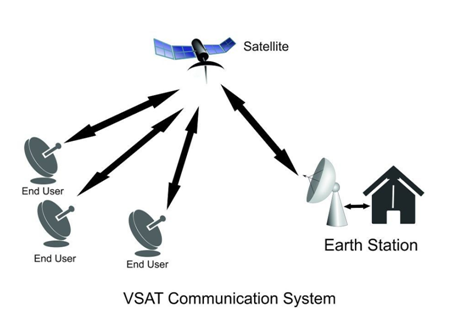Very Small Aperture Terminal (VSAT)
08-03-2024
01:27 PM
1 min read

What’s in Today’s Article?
- Why in the News?
- About Very Small Aperture Terminal (VSAT)
- How a VSAT Works?
- Advantages/Disadvantages of VSAT
- News Summary
- Collaboration with ISRO to Establish V-SAT Stations

Why in News?
- The Ministry of Tribal Affairs is planning to collaborate with ISRO to deploy V-SAT stations on a pilot basis for around 80 tribal villages.
About Very Small Aperture Terminal (VSAT)
- A very small aperture terminal is a two-way ground station that transmits and receives data from satellites.
- A VSAT is less than three meters tall and is capable of both narrow and broadband data to satellites in orbit in real-time.
- The data can then be redirected to other remote terminals or hubs around the planet.
How a VSAT Works?
- VSAT networks have a number of commercial applications, including, perhaps most notably, Enterprise Resource Planning (ERP).
- For example, the use of VSAT to track inventory was one of the many innovations Walmart (US-based retail store) pioneered in retail to effectively manage its vast inventory in real-time and reduce delivery costs between the warehouse and stores.
- Combined with the hub system of inventory storage, VSAT allowed Walmart to stock its stores more precisely and reduce how many times a product had to move between locations before being sold.
- Other manufacturers use VSAT to relay orders, check production figures in real-time as well as other functions that are otherwise handled over a wired network.
- The National Stock Exchange (NSE) in India has one of the largest VSAT networks in the world and offers it as one of its connectivity options.
- VSAT provided the NSE with a way to offer access in areas where wired options are limited.
- With the exception of the occasional sun outage due to solar radiation distorting signals from the satellite, the VSAT network has held up.
Advantages/Disadvantages of VSAT
- Advantages:
- VSAT networks have a big advantage when it comes to deployment.
- Because the ground station is communicating with satellites, there is less infrastructure required to service remote locations.
- This has made VSAT networks an ideal choice for providing connectivity to remote work sites, such as exploratory drilling sites that need to relay daily drill logs back to headquarters.
- VSAT is also independent of local telecommunications networks, making it an ideal system to back up wired systems and reduce business recovery risk.
- If the wired network goes down, a business can still go on using the VSAT network.
- VSAT networks have a big advantage when it comes to deployment.
- Disadvantages:
- However, VSAT does have limitations.
- The most obvious is latency, as it takes time for information to reach the dish and the station due to one part of the system being way up in geosynchronous orbit above the earth.
- In other words, protocols that require a lot of back-and-forth communication rather than one-way data transfer experience lag.
- The signal quality can also be affected by the weather and other buildings getting in the way.
News Summary
- The Union Ministry for Tribal Affairs (MoTA) recently launched ground-breaking partnerships for tribal development.
- The Ministry has collaborated with Indian Space Research Organization (ISRO), Indian Institute of Science (IISc) Bengaluru, All India Institute of Medical Sciences (AIIMS) Delhi, Indian Institute of Management (IIM) Calcutta, and Indian Institute of Technology (IIT) Delhi.
Collaboration with ISRO to Establish V-SAT Stations
- A gap analysis conducted by the Ministry of Tribal Affairs identified approximately 18,000 tribal majority villages with challenging accessibility due to remote locations and terrain.
- Inadequate mobile and internet connectivity in these areas hinders access to basic services.
- ISRO's satellite-based (V-SAT) solutions can significantly address these connectivity challenges.
- V-SAT stations can be static or mounted on vehicles.
- MoTA is partnering with ISRO to establish V-SAT stations at 80 Villages in 4 States on a pilot basis.
- These 4 States are Jharkhand, Madhya Pradesh, Odisha, and Maharashtra.
- These stations will offer Wi-Fi capacity of 100 Mbps, expandable to another 100 Mbps with boosters, enhancing connectivity and access to essential services for tribal communities.
- This pilot project would be monitored so that it could be scaled up to other similar tribal villages in other States as well, adding the goal is also to help with e-governance in these remote areas.


